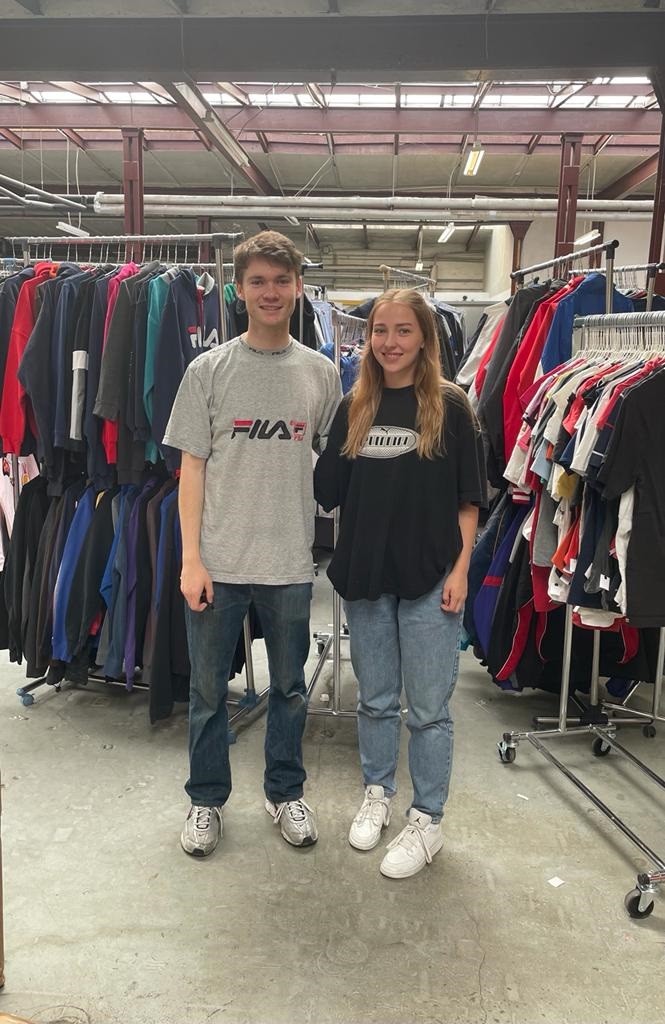Second-hand fashion has no longer a stale image and the market is constantly growing. At this point, sales in a hundred million range can be acquired. The clothing is advertised as sustainable, as an easy way to exit our consumer society. But does it really contribute to the movement of sustainable consumption?

November 2021, Große Ulrichstraße near the market square in Halle (Saale): countless people are standing a queue on the street. What seems like the entrance of a nightclub is in reality the opening of a store which is part of the thrift shop chain “Strike Wardrobe“.
A huge part of the waiting crowd heard about it through Instagram.
“Most of the people who get attracted are relatively young and want to buy as much as possible with their money.” says Daniel Bayen. The young entrepreneur opened the first thrift shop of the chain “Strike Wardrobe” in Krefeld. Today, the chain works with twenty wholesalers European wide. Strike competes with companies like Caritas or Vinted. “That is the reason why it is so important to get only the best clothes, to have the best profit margins “, explains Bayen. His concept taps on a major trend: a third of the German population buys second-hand fashion. Global Data, a market research company, predicts a market value increase of 77 billion US-Dollar worldwide.

Gentrification: second-hand fashion is a trend
Thrift shop fashion is getting more and more expensive without any particular reason. There are way too many used clothes in Germany. Half of them will be exported overseas and 15 to 19 percent gets recycled. Ten percent of each goes to thrift stores or people in need. Most of the time not even thrift shops can use the clothes because of their bad condition.
The increasing prices make second-hand fashion predominantly affordable to those who could easily buy fairtrade and sustainably produced clothing as well.
“It will be a problem if thrift stores are going to offer fast fashion for example, which is not necessarily cheaper than new fashion”, says Medina Imsirovic, an expert for international law. Fast fashion defines as trend related cheap fashion. The insufficient safety and environmental regulations in Indian and Bangladeshi fast fashion factories have been repeatedly reported in Germany. In combination with sewage, chemical waste ends up in rivers and lakes. Employees have no access to clean water and develop cancer or other diseases. Thrift stores are selling a significant part of discarded clothes from fast fashion brands. Imsirovic believes that fast fashion brands donate defect products to thrift shops on purpose. That way they save costs for disposal and the brand gets sold to costumers at the same time.
“There should be laws that focus on reducing the consumption of resources in supply chains.” demands Medina Imsirovic and explains: “On one hand, donating clothes for resale is a positive thing, on the other it is way too much and impossible for the thrift shops to sell all of it. But what is going to happen to the surplus of products?” Medin Imsirovic suggests to reduce the value of added tax on secondhand clothing. “Another possibility is to provide cheaper or free retail space. That is going to have an impact on the price as well.”
More sustainable than second-hand is not possible!?
In the meantime, the queue of people moved a bit. The first ones shove themselves into the building. A huge sign explaining the “rules of thrift-shopping” is blocking the entrance,
Point five on the list: “Cheaper and more sustainable than second-hand fashion is not possible, so shop without a bad conscience”.
“Basically, it makes sense to buy secondhand clothing because the resource consuming products get used again,” says Carmen Maiwald a journalist and garment technician. Around 20 percent of the water pollution worldwide is based on the dyeing of clothes. Buying second-hand fashion could reduce this. Also, a big part of the chemicals is already reduced because of previous washing procedures. But most of the clothes in thrift stores are produced by fast-fashion-brands. They use cheap material made of synthetic fibers like polyester for their production. With every washing procedure microplastic particles get loose and flow into rivers and oceans. Caren Maiwald confirms:
“The older a piece of clothing gets, the more particles it will release.” Nevertheless, her final judgement is not that bad after all: “Second-hand fashion is not a free pass for mindless consumption but a good opportunity to act environmentally responsible.”
Greenwashing
Luxury fashion brands recognize the awareness of sustainable clothes as well. “They try to green wash their products.”, says garment technician Carmen Maiwald mockingly. Gucci for example planted a tree for every sold “pre-loved” Gucci product in cooperation with “The RealReal”. Maiwald confirms that this kind of sustainable strategies are often green washing. A company stages an environmentally friendly image, without actually being environmentally friendly: “The company does not change any conditions in the production or works on creating resource ‑saving products. Consumers get fooled.”
Carmen Maiwald visited a refurbishment factory in the summer of 2021 which belongs to one of the biggest sorting companies in Germany. “Mainly women work in those factories. They are standing in front of sorting tables and have to recognize the quality of an article of clothing in only two seconds.” Scoreboards hang above the tables and show the already sorted pile of clothing of every worker. “If the amount is lower than the demanded number a red-light blinks — everyone recognizes that someone does not work fast enough”, remembers Maiwald.
Proud or ashamed of consuming
Carmen Maiwald points out that one can pay attention to certain things during the purchase decision: “You can choose if you want to buy at a kilo-shop (the price of the purchase is based on the weight) which receives its products from a big sorting company in Germany or if you go to a garage sale and buy the clothes of a private person or a social project supporting thrift shop.” Carmen Maiwald encourages to also pay attention to the material of the clothes.
Furthermore she explains: “We wash our clothes far too many times in Germany. Actually, it is completely fine to just air them out or wash out single stains.”
The first people step out of the store. A lot of them carry a new favorite piece of clothing. Most of them will come back, if not Strike, it is going to be another thrift store. Second-hand fashion is a major trend.
Author: Clara Therese Hoheisel
Translation: Clara Therese Hoheisel
Image Sources: privat
